Case Study: The Deepwater Horizon Oil Spill
VerifiedAdded on 2023/03/29
|6
|1080
|179
AI Summary
This case study examines the Deepwater Horizon oil spill, which occurred in 2010 and was caused by a blowout on the oil rig owned by British Petroleum (BP). The study explores the causes of the disaster, its environmental and economic impacts, and the response by BP. It also discusses the penalties and charges faced by BP and suggests crisis management strategies that could have been implemented to salvage the company's public image.
Contribute Materials
Your contribution can guide someone’s learning journey. Share your
documents today.
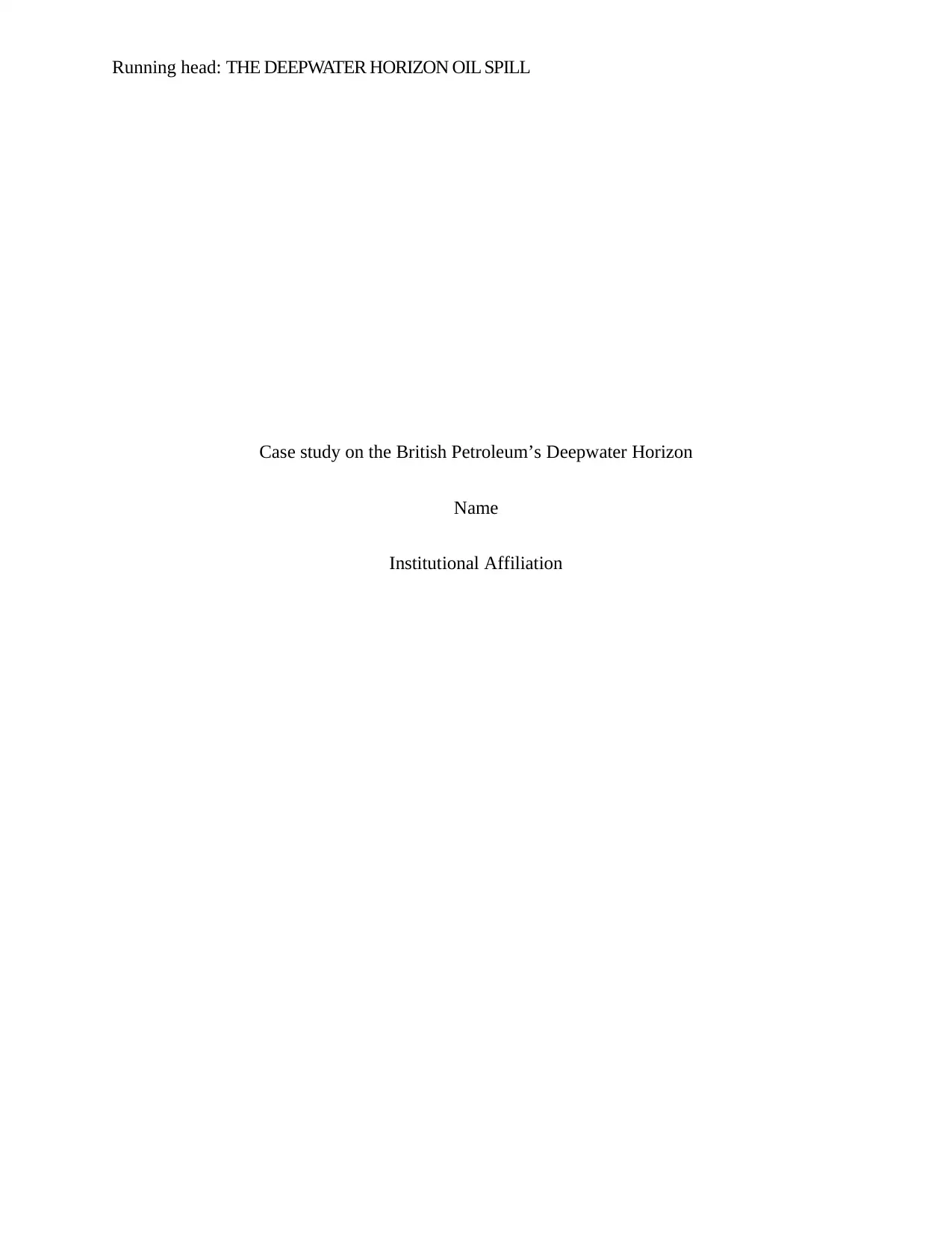
Running head: THE DEEPWATER HORIZON OIL SPILL
Case study on the British Petroleum’s Deepwater Horizon
Name
Institutional Affiliation
Case study on the British Petroleum’s Deepwater Horizon
Name
Institutional Affiliation
Secure Best Marks with AI Grader
Need help grading? Try our AI Grader for instant feedback on your assignments.
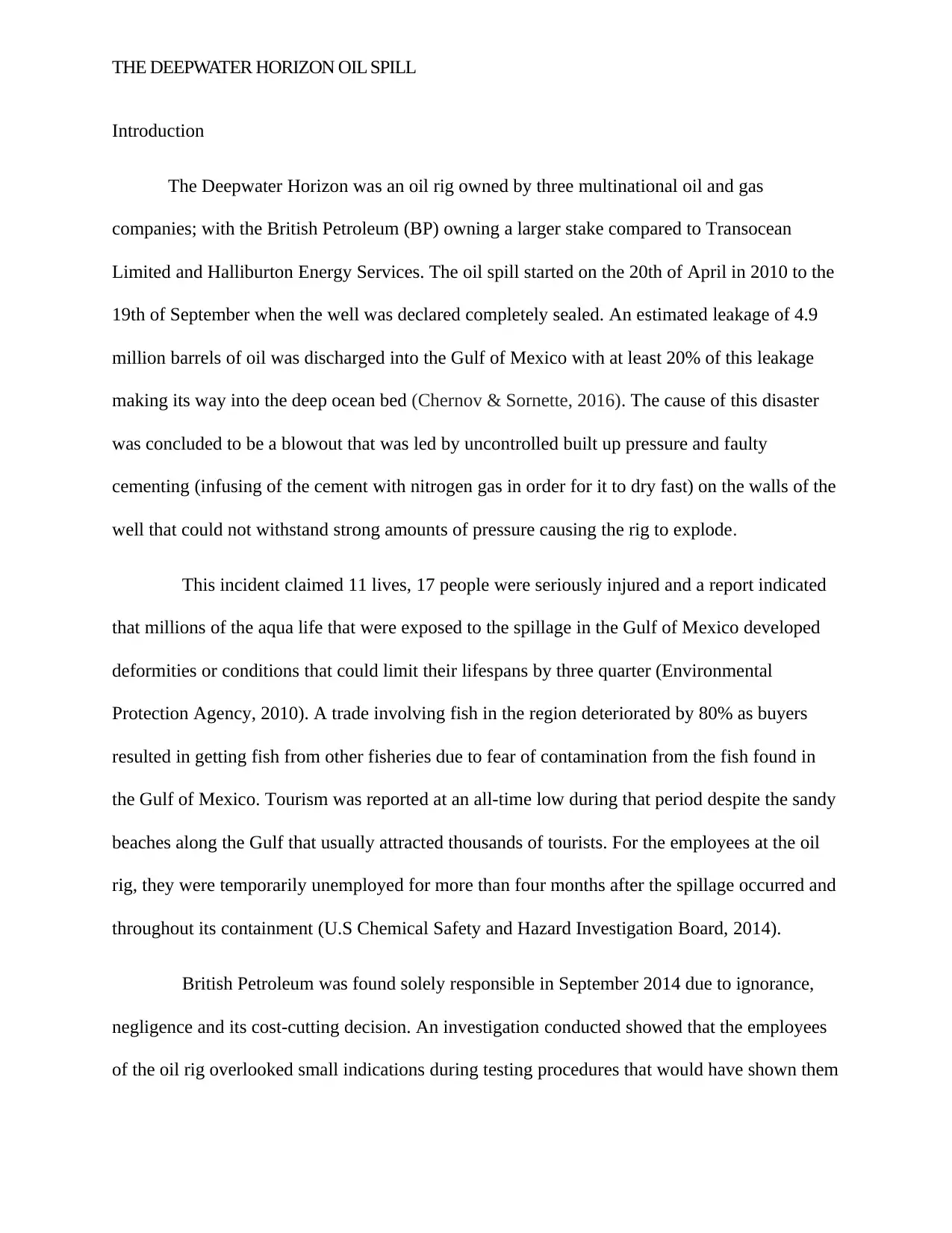
THE DEEPWATER HORIZON OIL SPILL
Introduction
The Deepwater Horizon was an oil rig owned by three multinational oil and gas
companies; with the British Petroleum (BP) owning a larger stake compared to Transocean
Limited and Halliburton Energy Services. The oil spill started on the 20th of April in 2010 to the
19th of September when the well was declared completely sealed. An estimated leakage of 4.9
million barrels of oil was discharged into the Gulf of Mexico with at least 20% of this leakage
making its way into the deep ocean bed (Chernov & Sornette, 2016). The cause of this disaster
was concluded to be a blowout that was led by uncontrolled built up pressure and faulty
cementing (infusing of the cement with nitrogen gas in order for it to dry fast) on the walls of the
well that could not withstand strong amounts of pressure causing the rig to explode.
This incident claimed 11 lives, 17 people were seriously injured and a report indicated
that millions of the aqua life that were exposed to the spillage in the Gulf of Mexico developed
deformities or conditions that could limit their lifespans by three quarter (Environmental
Protection Agency, 2010). A trade involving fish in the region deteriorated by 80% as buyers
resulted in getting fish from other fisheries due to fear of contamination from the fish found in
the Gulf of Mexico. Tourism was reported at an all-time low during that period despite the sandy
beaches along the Gulf that usually attracted thousands of tourists. For the employees at the oil
rig, they were temporarily unemployed for more than four months after the spillage occurred and
throughout its containment (U.S Chemical Safety and Hazard Investigation Board, 2014).
British Petroleum was found solely responsible in September 2014 due to ignorance,
negligence and its cost-cutting decision. An investigation conducted showed that the employees
of the oil rig overlooked small indications during testing procedures that would have shown them
Introduction
The Deepwater Horizon was an oil rig owned by three multinational oil and gas
companies; with the British Petroleum (BP) owning a larger stake compared to Transocean
Limited and Halliburton Energy Services. The oil spill started on the 20th of April in 2010 to the
19th of September when the well was declared completely sealed. An estimated leakage of 4.9
million barrels of oil was discharged into the Gulf of Mexico with at least 20% of this leakage
making its way into the deep ocean bed (Chernov & Sornette, 2016). The cause of this disaster
was concluded to be a blowout that was led by uncontrolled built up pressure and faulty
cementing (infusing of the cement with nitrogen gas in order for it to dry fast) on the walls of the
well that could not withstand strong amounts of pressure causing the rig to explode.
This incident claimed 11 lives, 17 people were seriously injured and a report indicated
that millions of the aqua life that were exposed to the spillage in the Gulf of Mexico developed
deformities or conditions that could limit their lifespans by three quarter (Environmental
Protection Agency, 2010). A trade involving fish in the region deteriorated by 80% as buyers
resulted in getting fish from other fisheries due to fear of contamination from the fish found in
the Gulf of Mexico. Tourism was reported at an all-time low during that period despite the sandy
beaches along the Gulf that usually attracted thousands of tourists. For the employees at the oil
rig, they were temporarily unemployed for more than four months after the spillage occurred and
throughout its containment (U.S Chemical Safety and Hazard Investigation Board, 2014).
British Petroleum was found solely responsible in September 2014 due to ignorance,
negligence and its cost-cutting decision. An investigation conducted showed that the employees
of the oil rig overlooked small indications during testing procedures that would have shown them
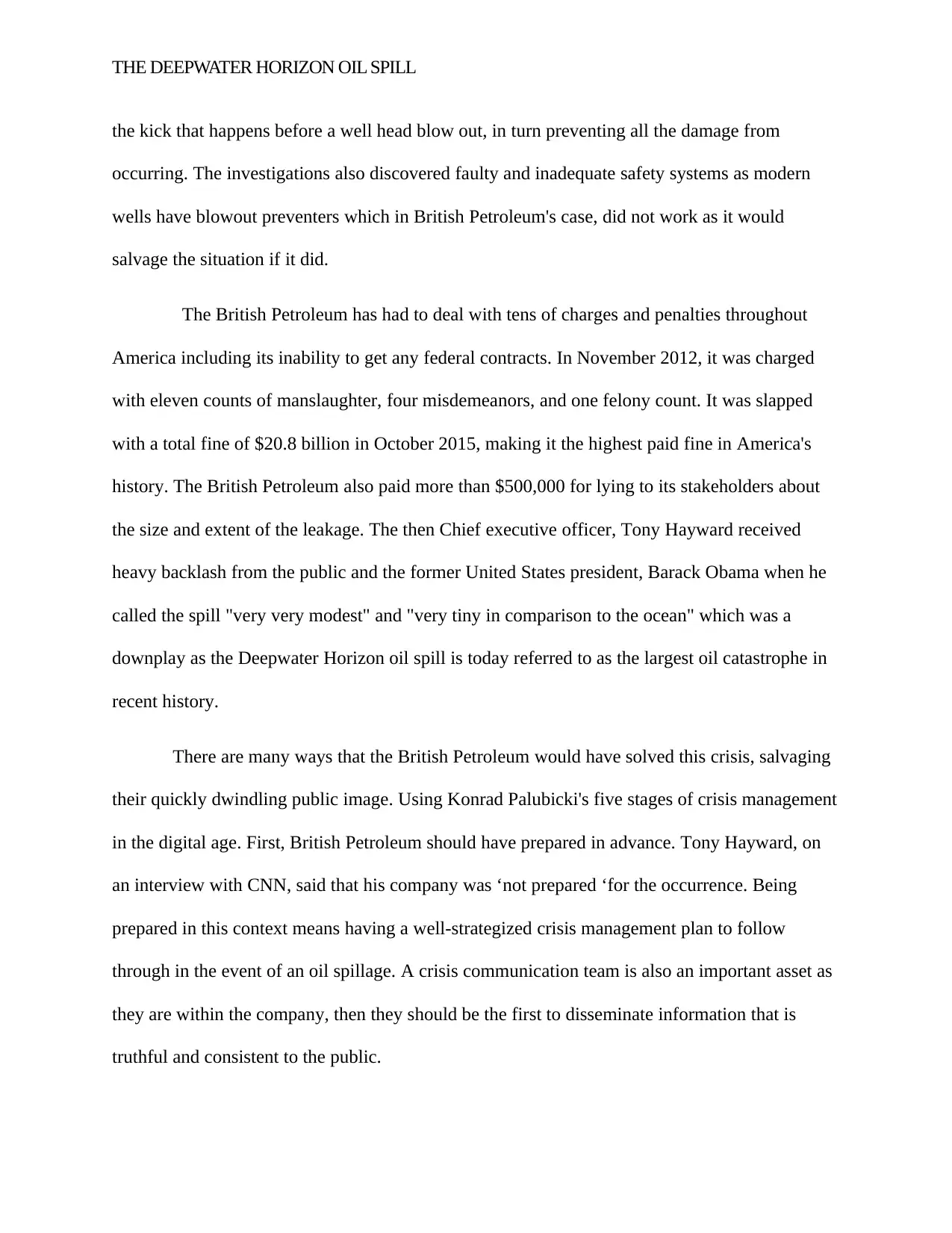
THE DEEPWATER HORIZON OIL SPILL
the kick that happens before a well head blow out, in turn preventing all the damage from
occurring. The investigations also discovered faulty and inadequate safety systems as modern
wells have blowout preventers which in British Petroleum's case, did not work as it would
salvage the situation if it did.
The British Petroleum has had to deal with tens of charges and penalties throughout
America including its inability to get any federal contracts. In November 2012, it was charged
with eleven counts of manslaughter, four misdemeanors, and one felony count. It was slapped
with a total fine of $20.8 billion in October 2015, making it the highest paid fine in America's
history. The British Petroleum also paid more than $500,000 for lying to its stakeholders about
the size and extent of the leakage. The then Chief executive officer, Tony Hayward received
heavy backlash from the public and the former United States president, Barack Obama when he
called the spill "very very modest" and "very tiny in comparison to the ocean" which was a
downplay as the Deepwater Horizon oil spill is today referred to as the largest oil catastrophe in
recent history.
There are many ways that the British Petroleum would have solved this crisis, salvaging
their quickly dwindling public image. Using Konrad Palubicki's five stages of crisis management
in the digital age. First, British Petroleum should have prepared in advance. Tony Hayward, on
an interview with CNN, said that his company was ‘not prepared ‘for the occurrence. Being
prepared in this context means having a well-strategized crisis management plan to follow
through in the event of an oil spillage. A crisis communication team is also an important asset as
they are within the company, then they should be the first to disseminate information that is
truthful and consistent to the public.
the kick that happens before a well head blow out, in turn preventing all the damage from
occurring. The investigations also discovered faulty and inadequate safety systems as modern
wells have blowout preventers which in British Petroleum's case, did not work as it would
salvage the situation if it did.
The British Petroleum has had to deal with tens of charges and penalties throughout
America including its inability to get any federal contracts. In November 2012, it was charged
with eleven counts of manslaughter, four misdemeanors, and one felony count. It was slapped
with a total fine of $20.8 billion in October 2015, making it the highest paid fine in America's
history. The British Petroleum also paid more than $500,000 for lying to its stakeholders about
the size and extent of the leakage. The then Chief executive officer, Tony Hayward received
heavy backlash from the public and the former United States president, Barack Obama when he
called the spill "very very modest" and "very tiny in comparison to the ocean" which was a
downplay as the Deepwater Horizon oil spill is today referred to as the largest oil catastrophe in
recent history.
There are many ways that the British Petroleum would have solved this crisis, salvaging
their quickly dwindling public image. Using Konrad Palubicki's five stages of crisis management
in the digital age. First, British Petroleum should have prepared in advance. Tony Hayward, on
an interview with CNN, said that his company was ‘not prepared ‘for the occurrence. Being
prepared in this context means having a well-strategized crisis management plan to follow
through in the event of an oil spillage. A crisis communication team is also an important asset as
they are within the company, then they should be the first to disseminate information that is
truthful and consistent to the public.
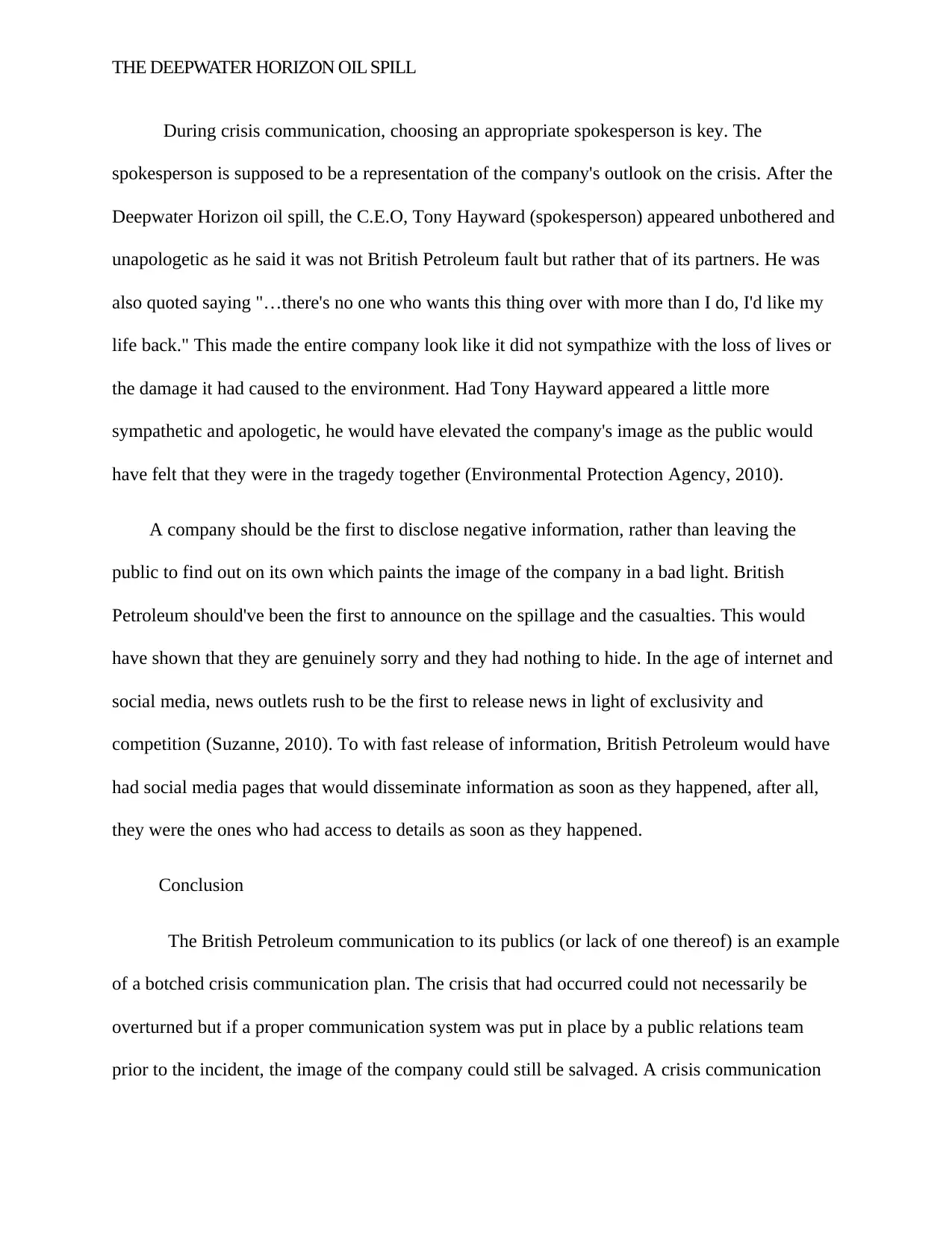
THE DEEPWATER HORIZON OIL SPILL
During crisis communication, choosing an appropriate spokesperson is key. The
spokesperson is supposed to be a representation of the company's outlook on the crisis. After the
Deepwater Horizon oil spill, the C.E.O, Tony Hayward (spokesperson) appeared unbothered and
unapologetic as he said it was not British Petroleum fault but rather that of its partners. He was
also quoted saying "…there's no one who wants this thing over with more than I do, I'd like my
life back." This made the entire company look like it did not sympathize with the loss of lives or
the damage it had caused to the environment. Had Tony Hayward appeared a little more
sympathetic and apologetic, he would have elevated the company's image as the public would
have felt that they were in the tragedy together (Environmental Protection Agency, 2010).
A company should be the first to disclose negative information, rather than leaving the
public to find out on its own which paints the image of the company in a bad light. British
Petroleum should've been the first to announce on the spillage and the casualties. This would
have shown that they are genuinely sorry and they had nothing to hide. In the age of internet and
social media, news outlets rush to be the first to release news in light of exclusivity and
competition (Suzanne, 2010). To with fast release of information, British Petroleum would have
had social media pages that would disseminate information as soon as they happened, after all,
they were the ones who had access to details as soon as they happened.
Conclusion
The British Petroleum communication to its publics (or lack of one thereof) is an example
of a botched crisis communication plan. The crisis that had occurred could not necessarily be
overturned but if a proper communication system was put in place by a public relations team
prior to the incident, the image of the company could still be salvaged. A crisis communication
During crisis communication, choosing an appropriate spokesperson is key. The
spokesperson is supposed to be a representation of the company's outlook on the crisis. After the
Deepwater Horizon oil spill, the C.E.O, Tony Hayward (spokesperson) appeared unbothered and
unapologetic as he said it was not British Petroleum fault but rather that of its partners. He was
also quoted saying "…there's no one who wants this thing over with more than I do, I'd like my
life back." This made the entire company look like it did not sympathize with the loss of lives or
the damage it had caused to the environment. Had Tony Hayward appeared a little more
sympathetic and apologetic, he would have elevated the company's image as the public would
have felt that they were in the tragedy together (Environmental Protection Agency, 2010).
A company should be the first to disclose negative information, rather than leaving the
public to find out on its own which paints the image of the company in a bad light. British
Petroleum should've been the first to announce on the spillage and the casualties. This would
have shown that they are genuinely sorry and they had nothing to hide. In the age of internet and
social media, news outlets rush to be the first to release news in light of exclusivity and
competition (Suzanne, 2010). To with fast release of information, British Petroleum would have
had social media pages that would disseminate information as soon as they happened, after all,
they were the ones who had access to details as soon as they happened.
Conclusion
The British Petroleum communication to its publics (or lack of one thereof) is an example
of a botched crisis communication plan. The crisis that had occurred could not necessarily be
overturned but if a proper communication system was put in place by a public relations team
prior to the incident, the image of the company could still be salvaged. A crisis communication
Secure Best Marks with AI Grader
Need help grading? Try our AI Grader for instant feedback on your assignments.

THE DEEPWATER HORIZON OIL SPILL
team should be put in place, this helps the response to the crisis very fast which gives the
company an upper hand in the public's eye.
team should be put in place, this helps the response to the crisis very fast which gives the
company an upper hand in the public's eye.
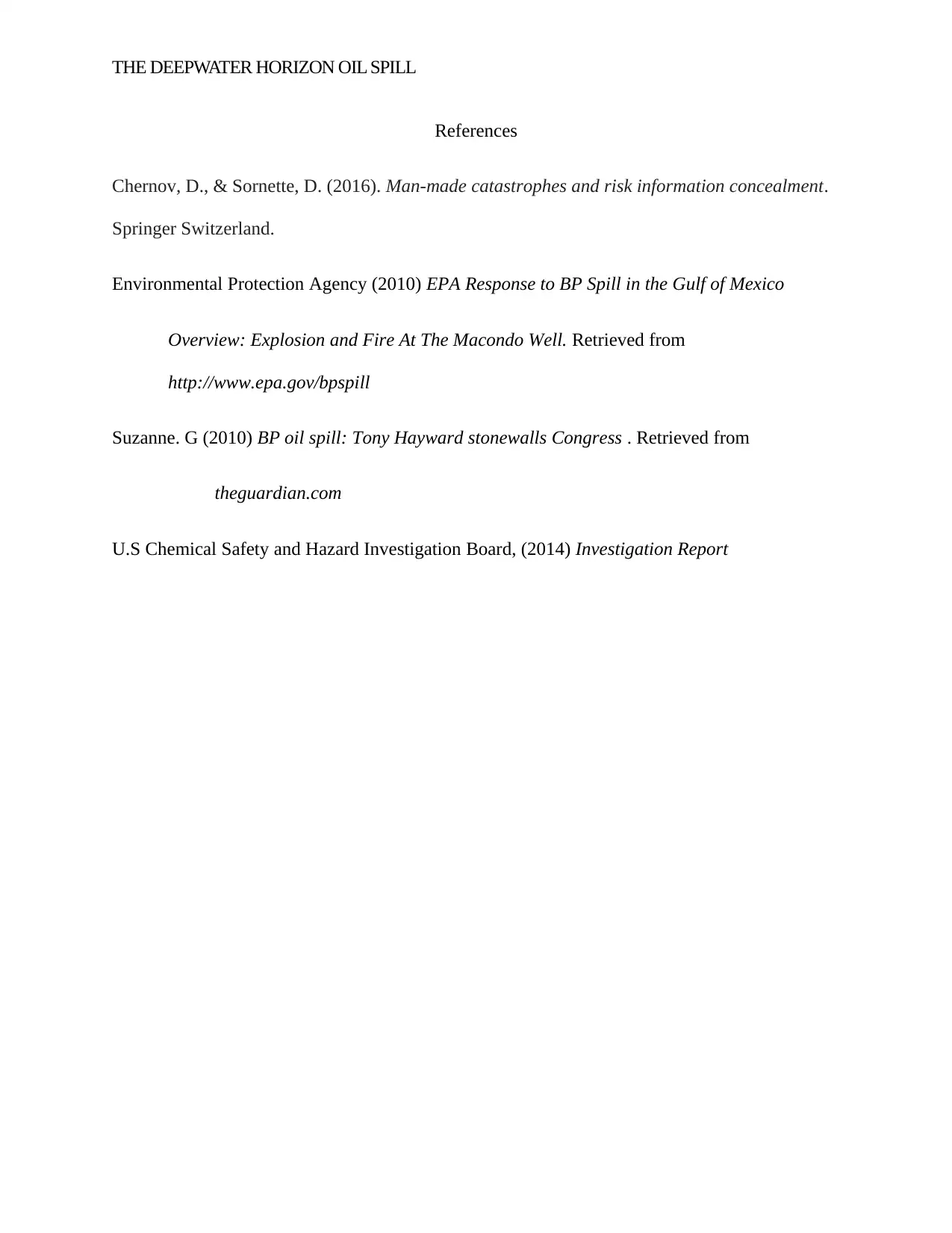
THE DEEPWATER HORIZON OIL SPILL
References
Chernov, D., & Sornette, D. (2016). Man-made catastrophes and risk information concealment.
Springer Switzerland.
Environmental Protection Agency (2010) EPA Response to BP Spill in the Gulf of Mexico
Overview: Explosion and Fire At The Macondo Well. Retrieved from
http://www.epa.gov/bpspill
Suzanne. G (2010) BP oil spill: Tony Hayward stonewalls Congress . Retrieved from
theguardian.com
U.S Chemical Safety and Hazard Investigation Board, (2014) Investigation Report
References
Chernov, D., & Sornette, D. (2016). Man-made catastrophes and risk information concealment.
Springer Switzerland.
Environmental Protection Agency (2010) EPA Response to BP Spill in the Gulf of Mexico
Overview: Explosion and Fire At The Macondo Well. Retrieved from
http://www.epa.gov/bpspill
Suzanne. G (2010) BP oil spill: Tony Hayward stonewalls Congress . Retrieved from
theguardian.com
U.S Chemical Safety and Hazard Investigation Board, (2014) Investigation Report
1 out of 6
Related Documents
Your All-in-One AI-Powered Toolkit for Academic Success.
+13062052269
info@desklib.com
Available 24*7 on WhatsApp / Email
![[object Object]](/_next/static/media/star-bottom.7253800d.svg)
Unlock your academic potential
© 2024 | Zucol Services PVT LTD | All rights reserved.





